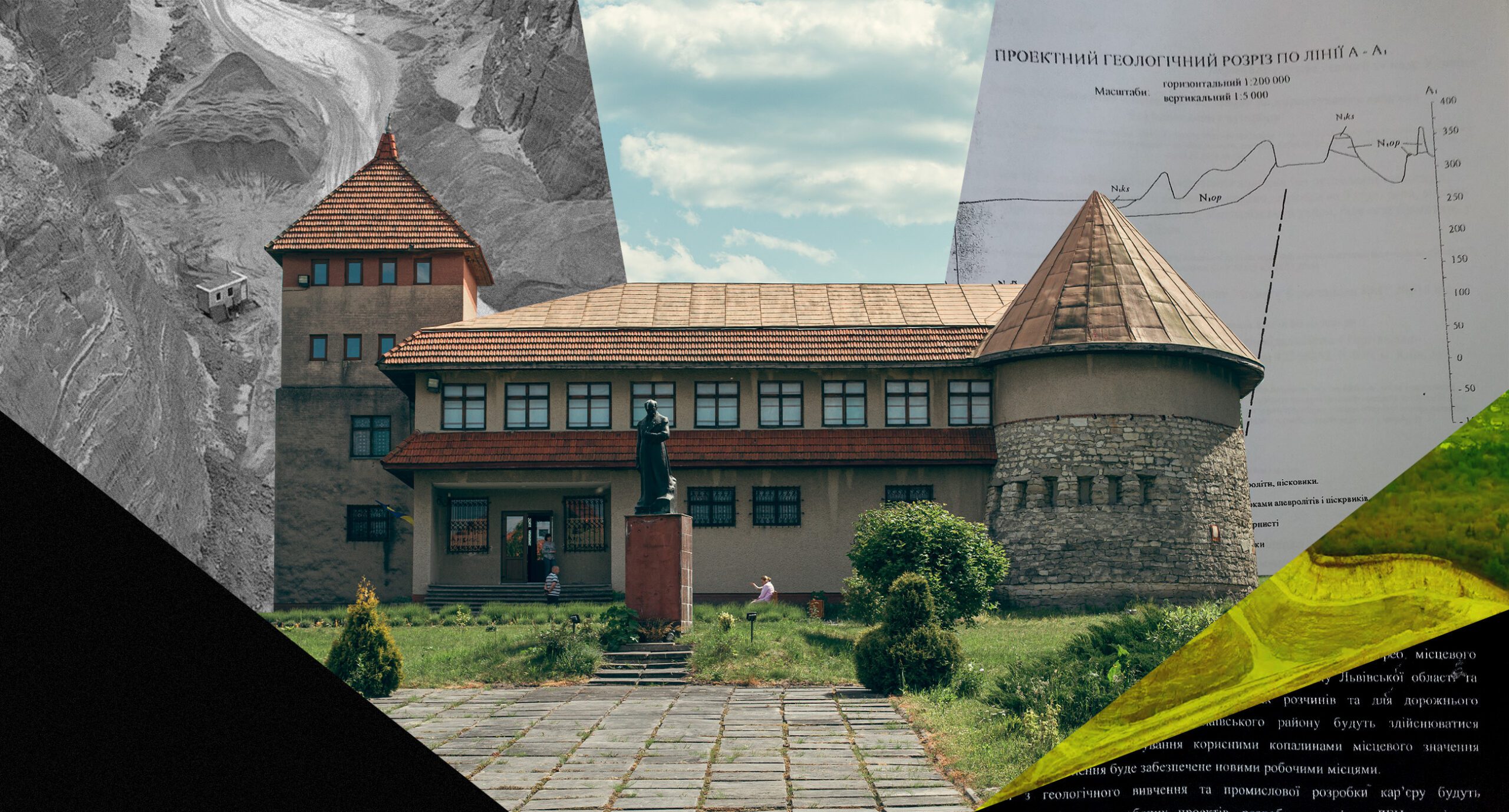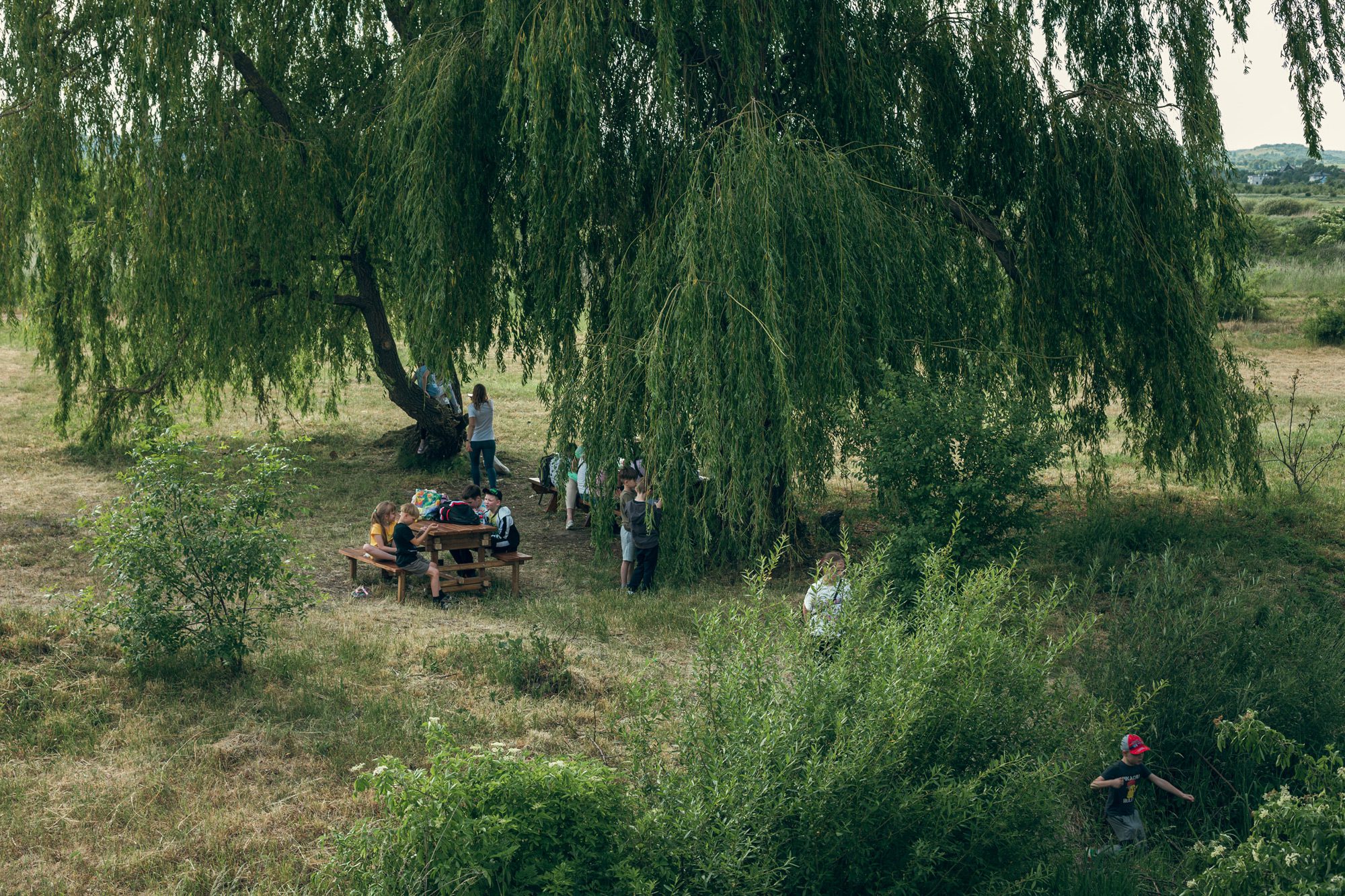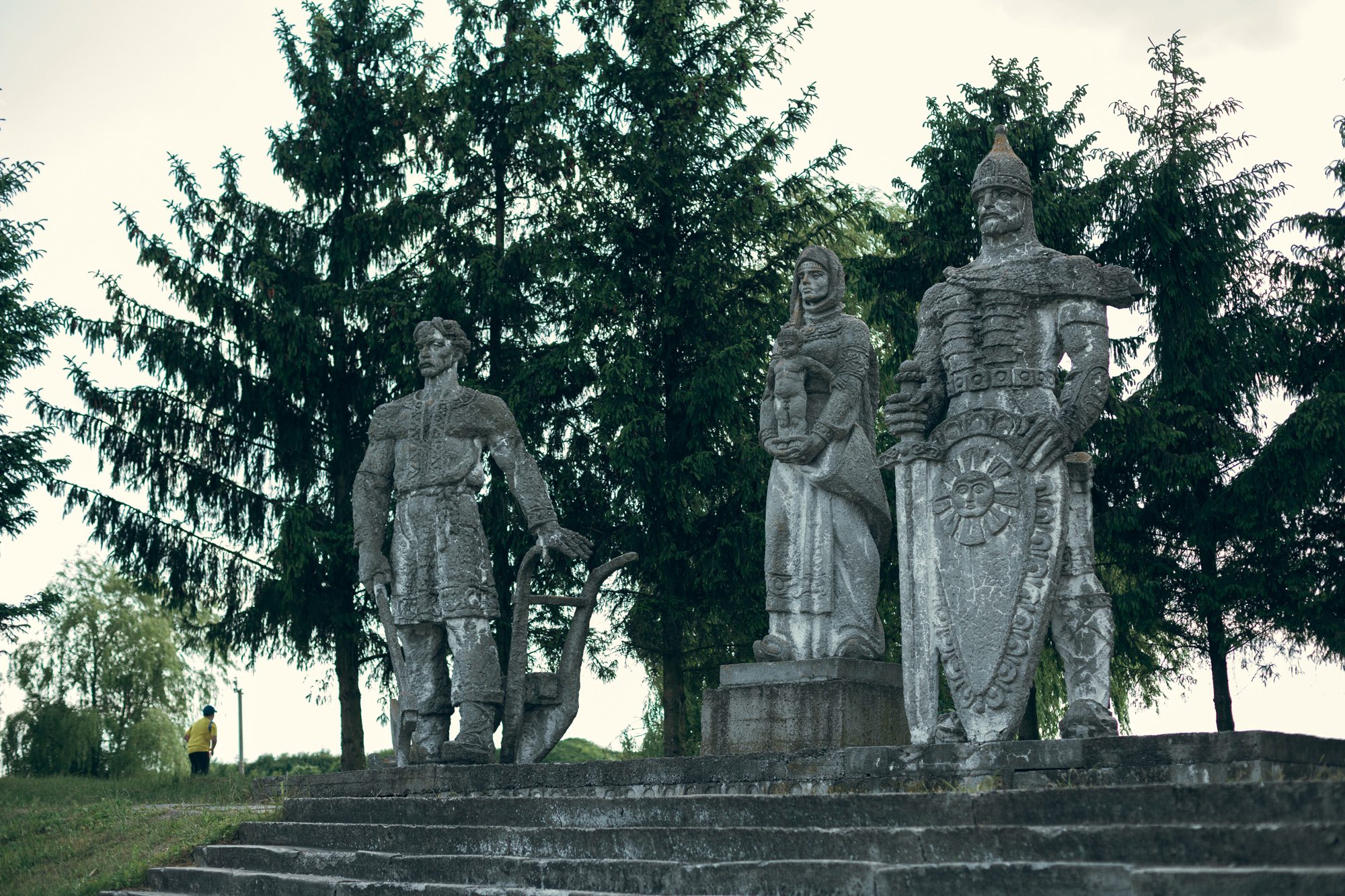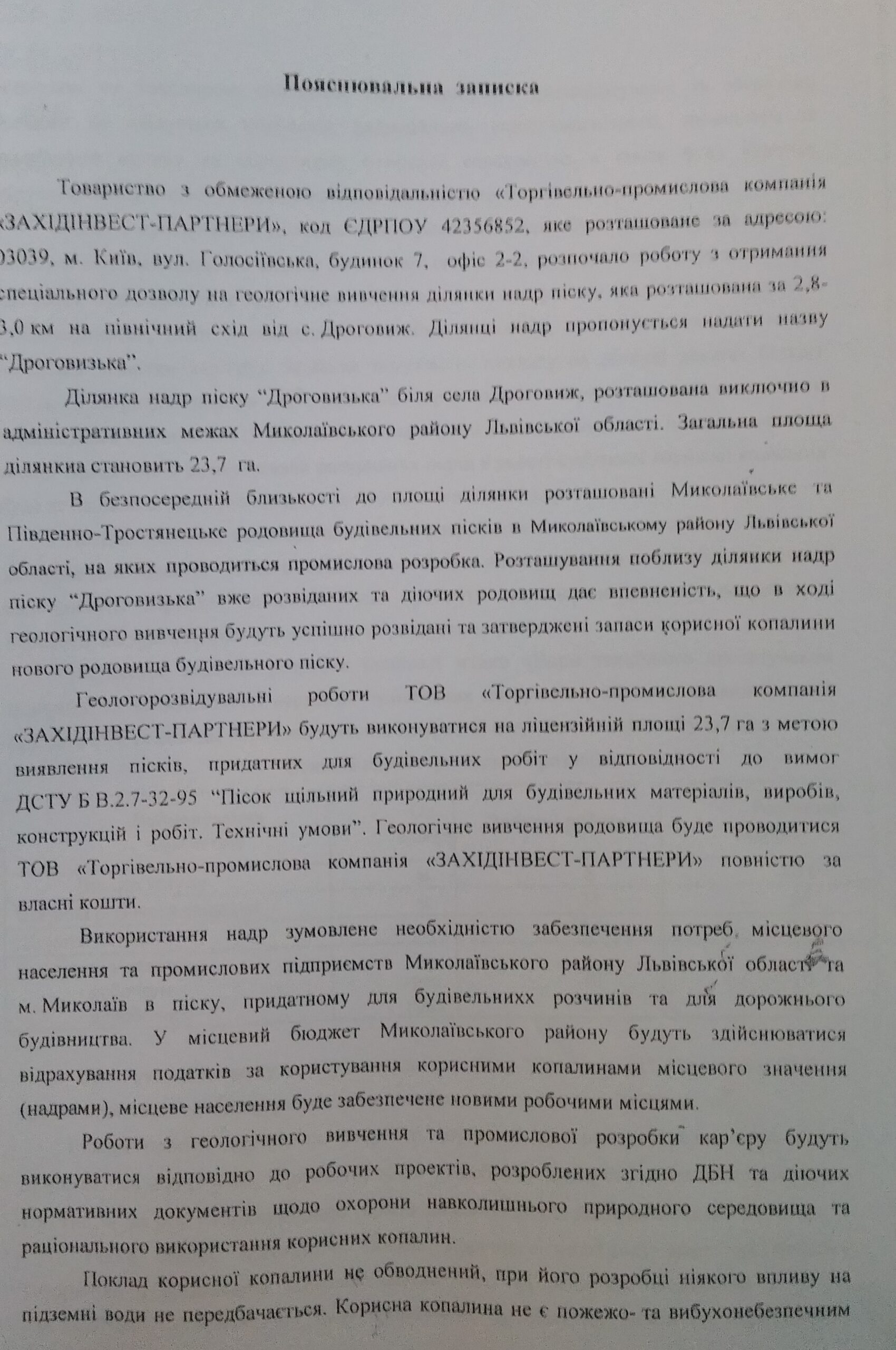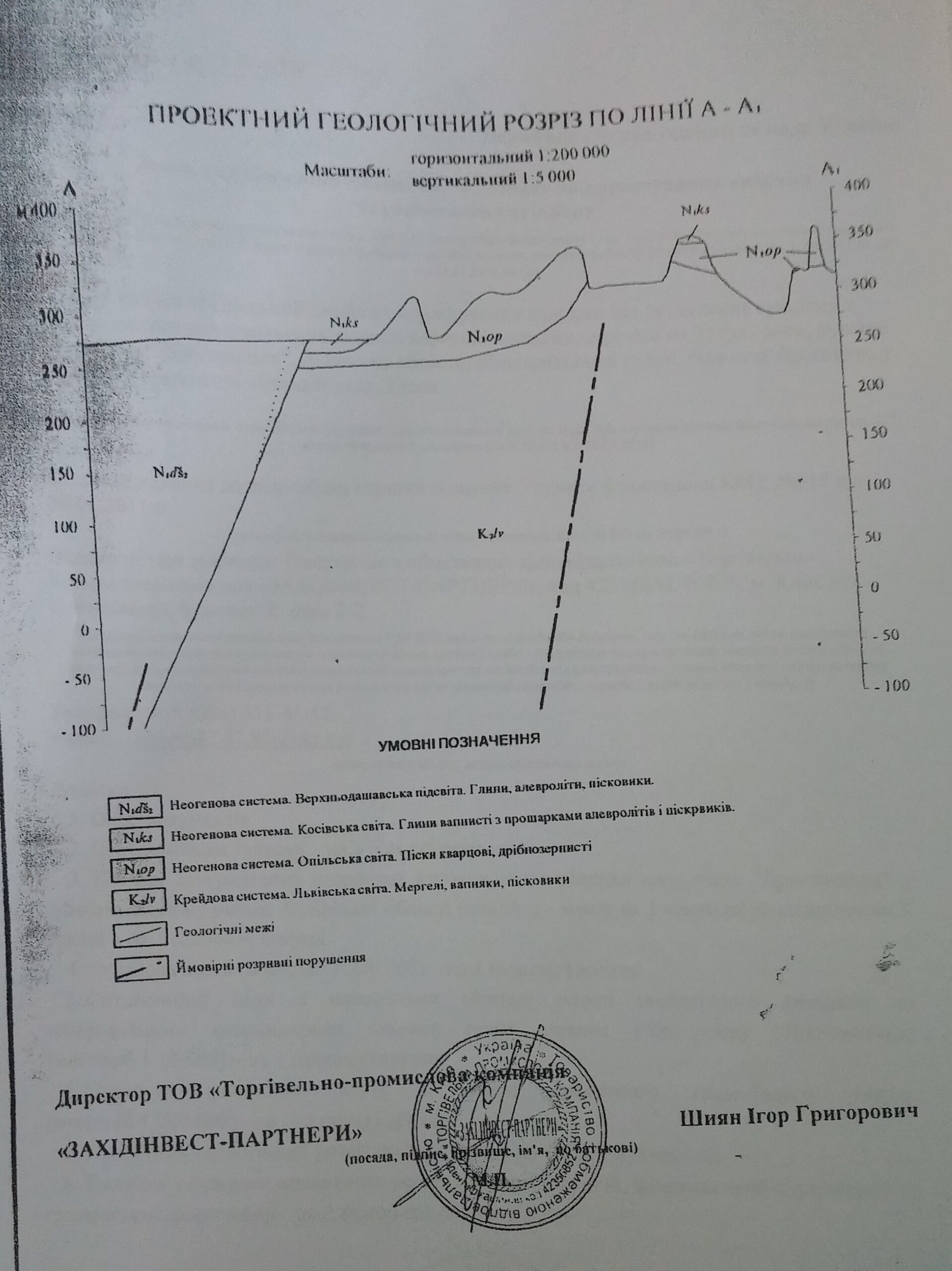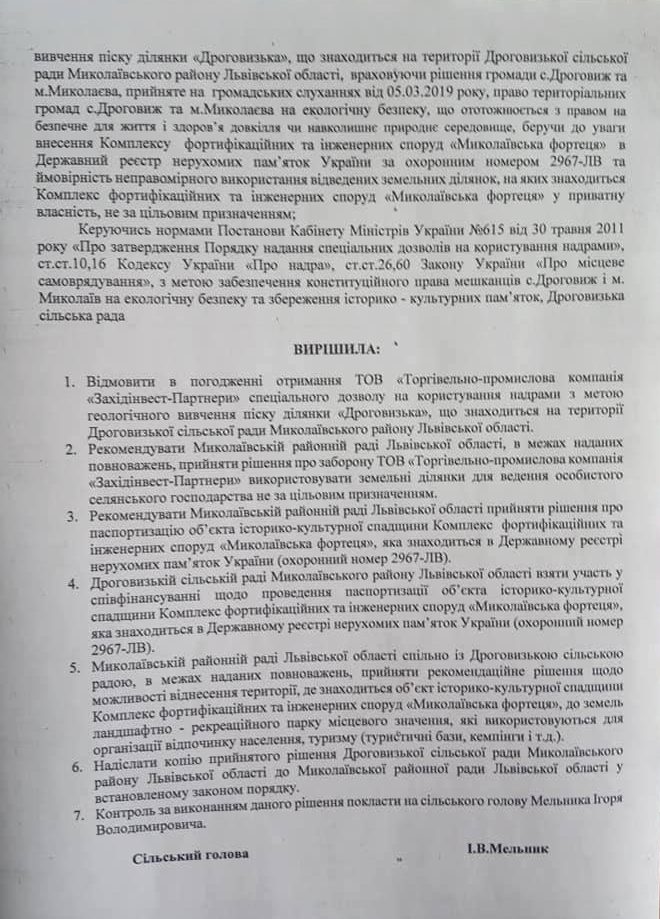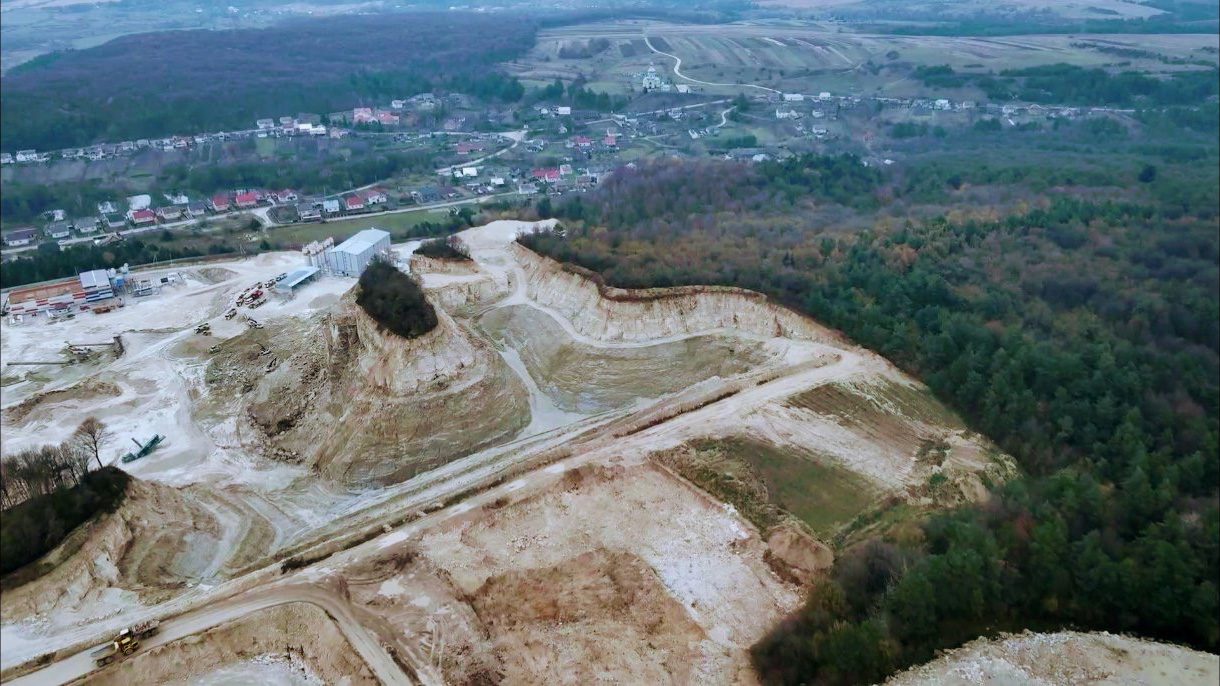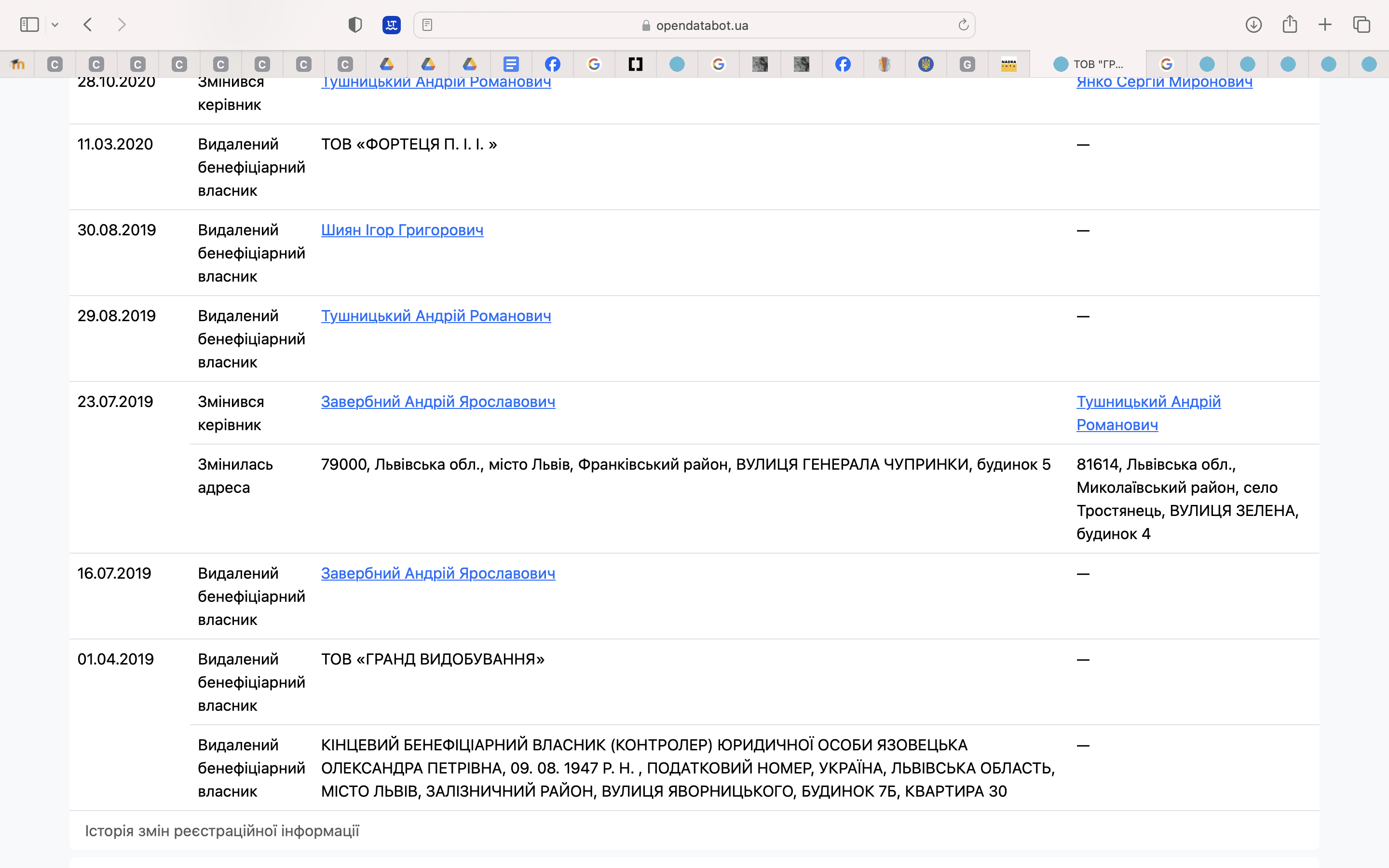The Mykolaiv Fortress is a complex of Austrian fortifications and engineering structures from the late 19th and early 20th centuries near the city of Mykolaiv in the Lviv region. This architectural monument of regional significance has become a bone of contention between business and monument preservationists.
In 2021, Vasyl Petryk, who fought for the preservation of the Mykolaiv Fortress, was arrested and accused of misappropriating budget funds during the development of the Ancient Zvenyhorod Historical and Cultural Park. His case has become a high-profile precedent for the persecution of cultural heritage defenders.
At the same time, private companies have been trying for years to obtain permits to develop sand quarries on the territory of the fortification complex. This led to a discussion about the balance between industrial development and the preservation of fortification monuments.
How it all began: Why we need to know about Ancient Zvenyhorod
The idea to create a reserve on the land of the princely city has existed since the Soviet Union, but it was finally realized in 2020.
Today, Ancient Zvenyhorod is an interactive museum and a territory of more than 25 hectares, where archaeological monuments related to the history of the chronicled Zvenyhorod are located. In the museum of the reserve, you can see an exhibition with artifacts of the princely city, learn about the Middle Ages, and explore the place in virtual reality. Thus, wearing VR glasses, visitors can see 12 locations of ancient Zvenyhorod, which have been recreated based on the results of scientific research. Four of them are the interiors of churches and palaces, and eight are streets, squares, and panoramas of the city.
Today, the reserve earns money by offering official paid services, from excursions to workshops. Due to the full-scale invasion in Ukraine, funding for large infrastructure projects in tourism and heritage preservation has stopped. Therefore, employees are focused on international grants, explains Myroslava Ivanyk, an employee of the Historical and Cultural Reserve.
However, they don’t have any, so they attract grants for smaller projects. For example, last year they managed to update the museum’s multimedia exhibition. Now visitors can read about the life of the medieval city on tablets and see 3D models of artifacts.
For the past two years, several museum employees have been doing all the maintenance. Even the security guards have been cleaning up the territory and mowing the grass on their own.
So why didn’t they have time to arrange a tourist attraction before the full-scale war with Russia? In whose interests was it to hinder the development of the archaeological park, and what do sand quarries have to do with it? This story has many threads, and concerns not only Zvenyhorod. Let’s take it one step at a time.

Zvenyhorod. Photo: Polina Kovalska
The case of Vasyl Petryk
In 2018, the project to develop the Ancient Zvenyhorod Historical and Cultural Park won a competition for regional development initiatives. The funding came from the state budget, which it has received from the EU. According to the decision of the Department of Architecture and Urban Development of the Lviv Regional State Administration, the funds for the work in Zvenyhorod were managed by the Belzkyi Mur Private Enterprise. From 2013 to 2021, it was headed by Vasyl Petryk, a defender of historical heritage, a PhD in architecture, and then head of the Department of Cultural Heritage Protection at the Lviv Regional State Administration.
At the end of October 2020, the Belzkyi Mur PE announced a tender for the restoration work on Prozorro platform, which was won by Galsad LLC. The contract was signed on December 16, 2020.
According to Vasyl Petryk, they wanted to create a recreational and archaeological park in Zvenyhorod: to lay down paths, to set up gazebos and observation decks. Funds for the project were allocated in December 2020, and the plan had to be implemented in a short time and in difficult weather conditions.
“When I first came there [to the reserve], it was a jungle of nettles and willow. We started clearing the territory to form an entrance around the shore so that water would not flood the area. That’s why we poured soil there,” says Petryk.
According to the Lviv Regional Prosecutor’s Office, it was during the transportation of the bulk soil that the information about the work performed and its cost was entered, but no transportation work was done. The police opened proceedings at the official request of Valeriy Potiuk, former director of the now-liquidated Lviv Region State Enterprise for the Restoration and Management of Castles and Palaces of Lviv Region.
On June 11, 2021, the Lviv Regional Prosecutor’s Office served four people, including Vasyl Petryk, with suspicion of misappropriating more than one million hryvnias of budget funds during the arrangement of a historical and cultural park (Part 5 of Article 191 of the Criminal Code of Ukraine). This article provides for punishment in the form of imprisonment for a term of 7 to 12 years with disqualification to hold certain positions or engage in certain activities for up to 3 years and confiscation of property.
On June 16, the Halytskyi District Court of Lviv imposed a pre-trial restraint on the heritage preservationist in the form of two months’ detention with the right to be released on bail in the amount of UAH 567,000. The three other defendants in the case were also imposed a preventive measure and taken into custody with different bail amounts.
After the pre-trial restraint was imposed, Vasyl Petryk was immediately taken to a pre-trial detention center. A large support group came to the courtroom with posters, and Petryk’s family immediately started raising funds for bail — they managed to do it in half a day. Most of the money came from people who supported the suspect — civic activists, unions, architects, restorers, etc.
Subsequently, on July 6, the Halytskyi District Court of Lviv decided to suspend Vasyl Petryk from the position of head of the Department of Cultural Heritage Protection of the Lviv Regional State Administration for two months. The man appealed, and the Lviv Court of Appeal overturned the decision to suspend him.
Thus, since 2021, the case has been at the initial stage. According to Vasyl Petryk, court hearings have been going on for two years.
“The current situation with the judicial system is such that I have great hope of defending my rights. The lawyers have evidence of violations during the proceedings, and the experts have evidence that contradicts the investigation. Therefore, I believe that we will defend ourselves in court, but it will take a long time,” says the heritage defender.
In the fall of 2022, Vasyl Petryk changed his position. He is now the head of the Urban Planning Documentation Department at the Ministry of Culture, where he deals with monument protection zones and historic cities. He is no longer involved in financial projects and says that the case has affected his life.
“I gained new experience working with lawyers, investigators, and law enforcement agencies,” the official says. “For my social circle, a day in a pre-trial detention center is like a badge of honor. But it had a heavy impact on my family, my colleagues, and the projects we were implementing. Because there was negative publicity: people are wary of trusting me because they see that I am under investigation.”

Zvenyhorod. Photo: Polina Kovalska
What does Mykolaiv Fortress have to do with it?
Vasyl Petryk called the case a trumped-up one because of his heritage protection activities, particularly with regard to the fortress near Mykolaiv, Lviv region.
“The first task of my opponents is to force me to stop working on the documentation for the inclusion of the Mykolaiv Fortress in the list of monuments through pressure and criminal cases,” he wrote on his personal Facebook page. “The second task is to destroy me as the newly appointed head of the Department of Cultural Heritage Protection of the Lviv Regional State Administration. It’s very simple: I am the only head of this department in recent years who has come from the field of monument protection and is ready to actively fight for the preservation of each monument, rather than negotiate and approve their development or destruction.”
“Mykolaiv Fortress is a complex of fortifications and engineering structures. They were built in stages: in the years of 1854-55, the 1890s, and in 1913-14. In particular, Austrian engineers built the Lysa Hora and Uhleryshche groups and three separate strongholds — Verin, Zubra, and Pod Debina. In the soil of Lysa Hora, they made trenches (underground tunnels) that could withstand heavy artillery fire, as well as command and observation posts and underground passages. The Austrians took advantage of the rocky sandstone and favorable terrain to create shelters protected from cannon fire. They served as a shelter for soldiers and ammunition, and the several-meter-thick soil protected them from shells. In total, at least 23 field fortifications were built here.
The greatest losses of Austrian fortifications in Galicia occurred during the Soviet era. Near Mykolaiv, active extraction of stones and sand from the local subsoil began after World War II. Thus, the construction of pipelines and agricultural activities led to the almost complete destruction of the fortifications built in 1854-55 and the 1890s, local researchers write. In the 2000s, the “work” of their predecessors was continued.
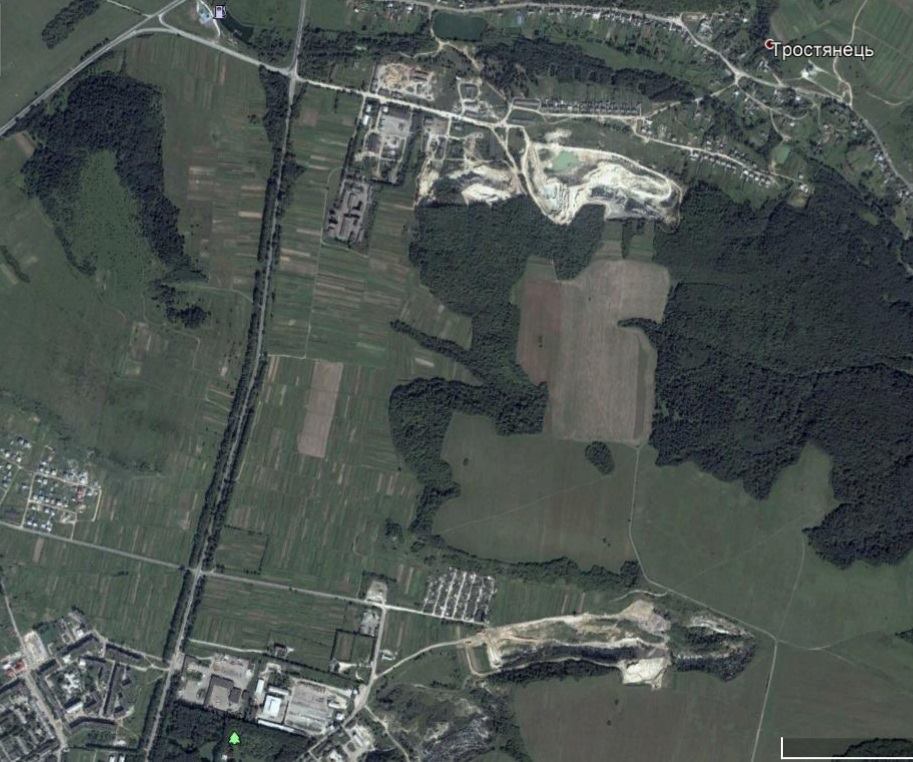
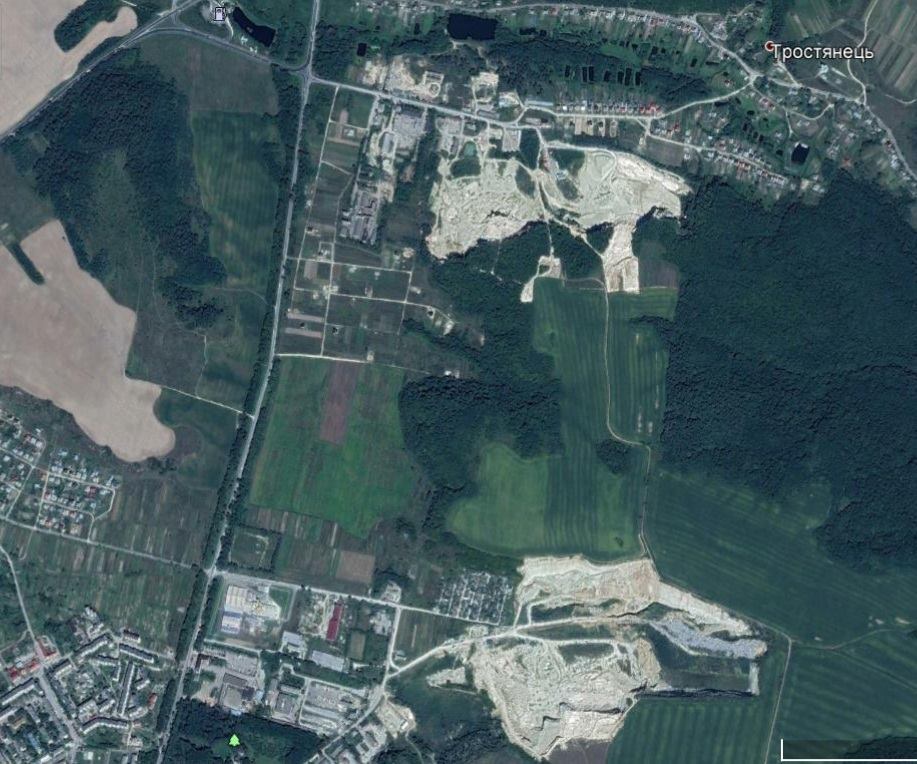
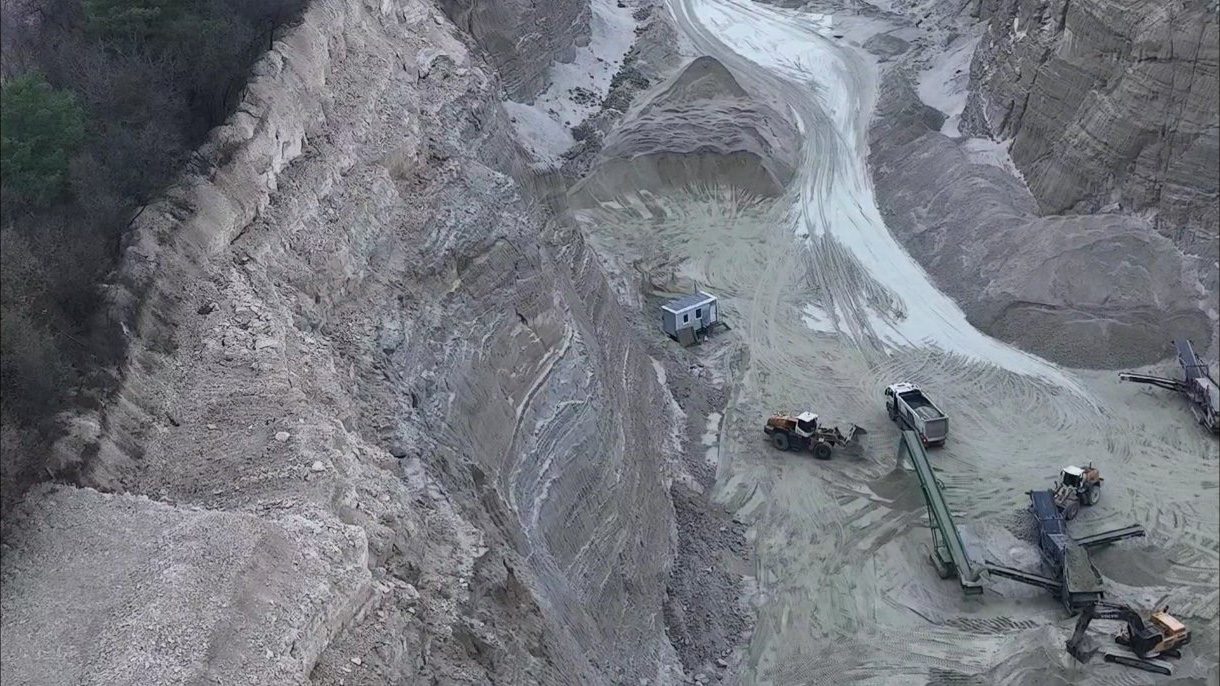
Sand quarry in 2023. Photo: Mykola Hnativ
How private companies and heritage preservationists fought for the Mykolaiv fortress
In 2015, Petryk was part of a group of scientists who developed a passport for a part of the Mykolaiv Fortress, the command post. In 2017, the fortress was assigned a security number and the command post was included in the state register of monuments of local significance. However, this was not enough for full protection, as the monument consists of 21 objects in total.
This was used by the owners of private companies, namely Zakhidinvest-Partners LLC. On October 3, 2018, the company’s director, Ihor Shiyan, sent an application to the State Service of Geology and Subsoil of Ukraine for a permit to use subsoil without an auction. The purpose was to conduct geological exploration of the Drohovyzka field for a period of three years. The explanatory note to the application stated that the company wanted to “meet the needs of the local population and industrial enterprises for sand,” as well as to pay taxes regularly and create new jobs.

Explanatory note. Photo courtesy of Olena Sulikovska
In February 2019, the then Mykolaiv District Council, at the request of the same State Service of Geology and Subsoil of Ukraine, approved geological studies of sand by Zakhidinvest-Partners (in accordance with decision No. 403) at the Drohovyzka site, which is almost 24 hectares in size.
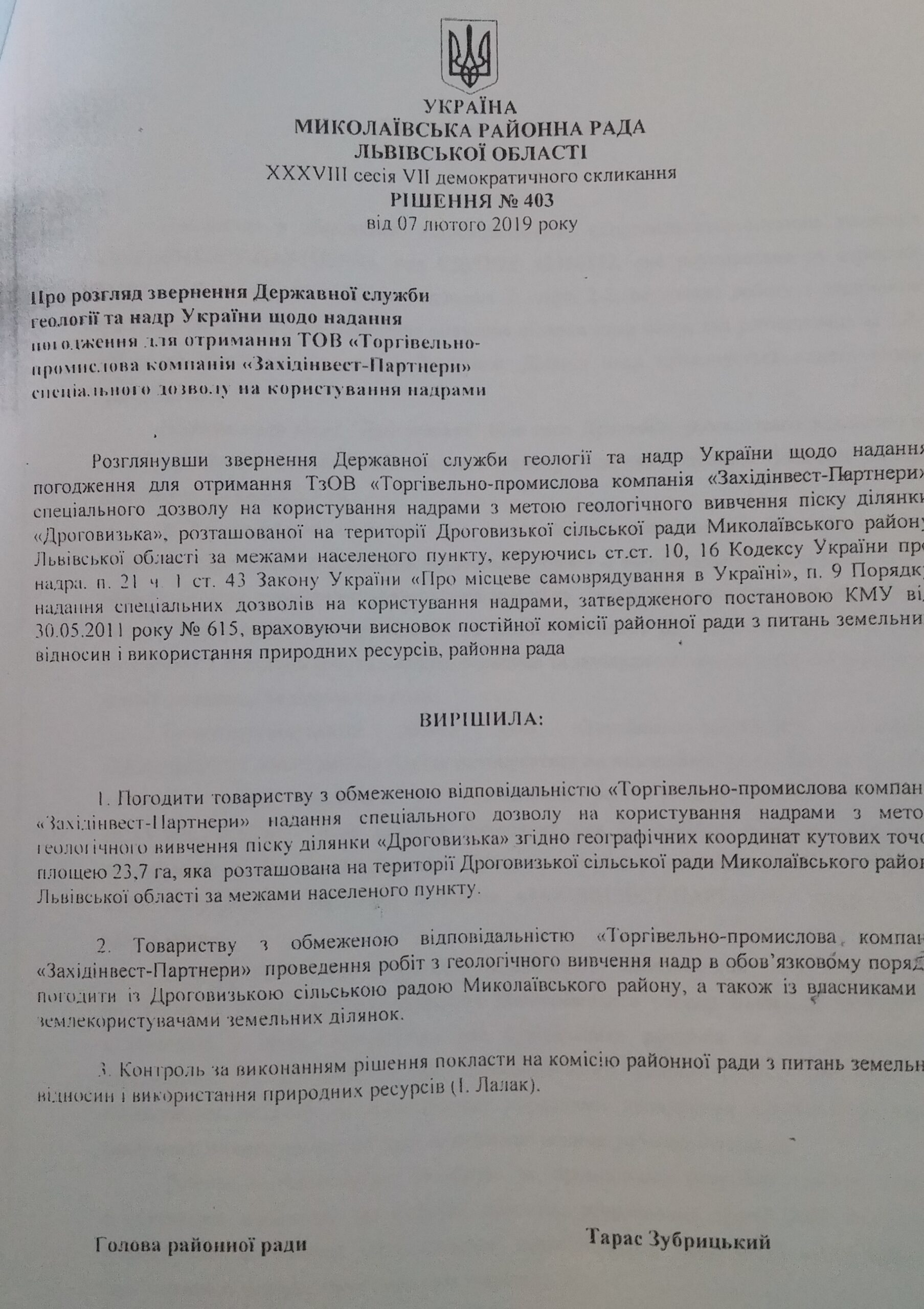
District Council decision No. 403. Photo courtesy of Olena Sulikovska
The same site is included in the Register of Historical Monuments of Local Importance (protection number 2967-LV), so carrying out work, including soil exploration, requires an approval from the cultural heritage protection authorities.
In addition, the aforementioned explanatory note on the work of Zakhidinvest-Partners LLC referred to a 50-meter-deep quarry and did not mention any potential damage to the local ecosystem. The fact is that the sands that were planned to be mined are a hydroaccumulative layer that replenishes the surrounding groundwater.

Project geological section. Photo courtesy of Olena Sulikovska
It also turned out that the geographical coordinates of the corner points of the Drohovyzka sand area coincided with the location of the Mykolaiv Fortress complex. So the community — historians, local historians, and other concerned residents of the area — reacted to this decision of the district council. Since residents of the neighboring village of Drohovyzh and members of the village council did not support the permission to explore the sand, the district council’s decision was canceled two months later.

The decision of the Drohovyzh village council session. Photo courtesy of Olena Sulikovska
It is interesting that in 2019, in addition to Zakhidinvest-Partners LLC, two other companies tried to get their hands on the monument — MMShBD No. 38 and Private AgroFarm Dnister. Thus, at a session of the Mykolaiv District Council, they considered whether Mykolaiv Road Construction District No. 38 should be allowed to expand the Novotrostianets sand deposit near the fortress. Despite the fact that its protection boundaries have not yet been determined due to the ignoring of the orders of the Trostianets community. Subsequently, Dnister wanted to obtain a mining allotment for 102 hectares of land next to the monument, which was opposed by members of the Lviv Regional Council and public activists.
Falsified signatures and personnel issues at the Ministry of Culture
Meanwhile, the Mykolaiv District Council asked Vasyl Petryk’s Belzkyi Mur company to prepare the project documentation for other objects, such as a group of fortifications on Lysa Hora, which is part of the Mykolaiv Fortress (“Boundaries and Regimes of Protection Zones for the Local Historical Monument Complex of Fortifications and Engineering Structures “Mykolaiv Fortress”). In 2019, these documents were approved by the Lviv Regional State Administration and sent to the Ministry of Culture. The expert commission reviewed them and decided to include the fortifications in the Register as a monument of local significance. However, later it was discovered that the monuments lacked documents and had not been properly researched. So the listing was suspended.
As it turned out, in 2020, the Ministry of Culture received another set of documents for the same fortress sites, which were prepared by another company, the Restoration and Management of Castles and Palaces of Lviv Region, headed by Valeriy Potiuk. Officials had to recognize that the caves belonged to the heritage of science and technology and that the strongholds had no signs of cultural heritage. Thus, according to the expert committee, the sites are not associated with important historical events and the lives of famous people. In addition, archaeological research in the area allegedly found no traces of World War I hostilities, as there are no reliable historical sources. At the same time, the underground tunnels were a military-engineering facility of the early twentieth century, so they were classified as objects of science and technology.
As for the strongholds “North,” “West,” and “East,” as well as the “Field Fortifications,” the expert committee decided that they do not have the characteristics of a cultural heritage site, as their authenticity and structure have not been preserved due to the destruction by time. Therefore, these parts of the complex were not included in the State Register of Immovable Monuments.
According to Suspilne Lviv, the Zakhidinvest-Partners company applied for the municipal enterprise of Potiuk. It was the company that wanted to obtain a special permit for geological exploration of the sand. The utility company, in turn, turned to the Ukrainian State Institute of Cultural Heritage, headed by Iryna Prokopenko. She also wrote a review of Potiuk’s company. But the conflict lies in the fact that Prokopenko was also a member of the expert commission that determined the monuments as having no signs of cultural heritage.
At the beginning of 2021, the Lviv Regional State Administration received a decision from the Ministry of Culture on the documents developed by the regional council’s municipal enterprise. This is when the alarm was raised because the documents bore the signature of Andriy Hrechylo, a doctor of historical sciences and an expert in heraldry. That same year, he was called to a meeting at the Department of Architecture and Urban Development, where Valeriy Potiuk and Vasyl Petryk were present. Hrechylo said that his signature was forged and wrote a statement to the district police department. The examination in this case has been going on for three years.
“I was called to the prosecutor’s office to conduct an examination. They told me to write off one letter with my autograph and five more with various text. When I asked if the examination was ready, I was told that the experts were busy. Later, they called me and asked to bring old documents with my signature on them. I have the impression that no one is investigating anything there, and the case has been frozen,” the expert says.
“We sent a request to the Ministry of Culture for a copy of the documents of the Lviv Region Restoration and Management of Castles and Palaces, on the basis of which the expert commission made its conclusions. But as it turned out, they were seized from the ministry on the basis of a ruling by the Halych District Court of Lviv. We also asked about the personal composition of the commission — it was changed by the order of the ministry, and the aforementioned Iryna Prokopenko is no longer there.
Also, in response to a request to the Lviv Regional State Administration, we were informed that the Horzhevi Caves remained a monument of science and technology.”
Different companies under the supervision of the same business partners
In parallel with the case against Vasyl Petryk, in April 2021, the Lviv Regional State Administration once again classified the complex of historical buildings of the fortress as newly discovered monuments and decided to produce documentation for them. The relevant order was signed by the head of the Lviv Regional State Administration, Maksym Kozytskyi.
However, this did not stop the sandy interests of private companies. In the spring of 2021, Grandiland applied for a new quarry that would cover part of the fortifications at Uhleryshche and the Treditoren casemate battery near Trostianets. However, the company was unanimously rejected at the session of the Mykolaiv Territorial Community. Interestingly, the list of final beneficiaries, according to the Clarity project, includes Andriy Tushnytskyi. He is also one of the founders of the MMShBD-38, where he collaborated with Ihor Shyian from the already well-known Zakhidinvest-Partners company. Thus, at least three quarry development companies have the same founders or beneficiaries.
Continuation of the Lysa Hora case
But let’s get back to the facilities at Lysa Hora, for which Vasyl Petryk prepared the accounting documents. Thus, in 2022, the Lviv District Administrative Court held a hearing on the lawsuit filed by the aforementioned entrepreneur Andriy Tushnytskyi against the Department of Architecture and Urban Development of the Lviv Regional State Administration. The essence of the lawsuit is to cancel the order that approved Petryk’s research and design documentation for the Lysa Hora group in 2019.
The fact is that in 2020, Tushnytskyi acquired land plots with a designated purpose for agriculture. It is on these plots that the Lysa Hora group’s fortifications are located. The Department issued an order to establish the security boundaries on May 22, 2019, but the Lysa Hora group objects were included in the State Register of Immovable Monuments of Ukraine in 2022.
Thus, the court was able to prove that at the time of the purchase of the plots, there was no question of monuments. The entrepreneur also proved in court that the department had no right to set the security boundaries of the Mykolaiv fortress, as stated in the challenged order. The protected zone coincides with his private land plots.
The court concluded that at the time of adoption of the challenged order, the objects of the Lysa Hora group were not included in the State Register of Immovable Monuments of Ukraine, which “indicates that it is premature to determine the boundaries and modes of use of the protection zones”. Thus, the Lviv District Administrative Court canceled the order of the Regional State Administration to establish the boundaries and protection zones of the historical monument.
According to Vasyl Petryk, developers consider procedural issues above the general legislative ones. Thus, business stands against cultural heritage.
“There is a dissonance: on the one hand, we need monuments to bring tourists, but on the other hand, they are a hindrance. It’s the same here: the monuments got in the way of the sand-buying. It came as a shock to businesses, because when they bought the land, there were no monuments. And as it turned out later, there were. But the fact is that the monuments had always been there, it’s just that no one had informed the landowners. That’s why they blamed the monuments’ preservationists,” Vasyl Petryk comments on the case.
Mykolaiv Fortress: What is happening now?
Mykolaiv Fortress is located on the territory of Mykolaiv, Trostianets, and Rozvadivka Territorial Communities. Landowners in the Mykolaiv Community were sent letters about the historical heritage sites on their plots. Almost all owners read these letters in August 2021.
Then the fortifications had to be included in the balance sheet. But to do this, it was necessary to determine the balance value. The Mykolaiv City Council announced a tender several times, as there are few organizations authorized to evaluate historical heritage sites. When the full-scale war broke out, the case was frozen.
Later, in December 2022, the Parliament adopted the “Small Subsoil Code”. Now, the period for obtaining permits for the extraction of sand and other minerals has been reduced by three times. Companies can now freely sell their mining permits to other firms, and owners of small land plots of up to 25 hectares can extract minerals without an auction. Overall, the reform aims to develop the industrial processing of raw materials in Ukraine. But at the same time, it creates risks, such as in the case of Mykolaiv Fortress.
According to Mykola Hnativ, a local historian and candidate of geological sciences, sand is currently being actively mined at the Pivdenne-Trostianets deposit. Thus, the community is mining sand and getting closer to the Traditoren stronghold (Uhleryshche group). At the same time, the protection zone of the monuments includes more than 300 meters outside the settlements.

A view of Trostianets, November 9, 2023. Photo: Mykola Hnativ
In Trostianets, a sand quarry is being developed on agricultural land that entrepreneurs managed to buy from the owners of the land shares. But they are doing this without reassigning the land purpose to ‘quarry.’ At the same time, according to expert Mykola Hnativ, when a quarry is already being developed, the plots can be recultivated for future farming. This means the full or partial restoration of land and its productivity that has been damaged by economic activity. However, the local historian notes that this has not yet been practiced in the Lviv region, and usually everything grows back naturally in 20–30 years.
But there is another nuance: currently, no one can influence the situation with the current quarries, because they have not yet been taken on the balance sheet, explains Hnativ. However, in addition to the fact that the land is being used for other purposes, a private company would have to produce documents for sand mining.
The local historian is reluctant to talk about who is involved in the sand business. However, he notes that one of the most recent companies is Grand Vydobuvannya. We cannot currently confirm or deny the information whether this company is the one that is working in the Trostianets community. However, the village council told us that they did not grant any approvals to this particular company for the use of subsoil, and they have no information about the geological study of sand at the Pivdenno-Trostianetske field.
However, it is interesting to note that the owner of the corporate rights to Grand Vydobuvannya is Grandiland, which we mentioned above. At the same time, in 2019, Grand Vydobuvannya was among its beneficial owners. Obviously, the companies have a long-standing relationship.

Change of owners of Grandiland LLC. Screenshot courtesy of Olena Sulikovska
The village council also informed us that the “Command Post of the Mykolaiv Fortress” is located on state-owned land that is used by the Mykolaiv State Forestry and Hunting Enterprise and is part of the administrative boundaries of the Trostianets community. It is listed in the register as a historical monument of local significance. However, we were never answered when we asked whether it had a protected zone. They said that there were documents for the site, but the council did not have them. And in the state register, the address is listed in the Mykolaiv Territorial Community.
And finally, the inclusion of monuments in the register does not mean their actual protection. Therefore, the main thing in the preservation of the Mykolaiv Fortress is to define the boundaries of the monuments. In the case of sand mining, this actually means a buffer zone between the monuments and private companies. But it’s not that simple, as this requires signing contracts with landowners whose territories coincide with the protected zones.
The Department of Architecture and Urban Development told us that at the time of the request (June 11), the owners of monuments or parts of monuments or their authorized bodies had not applied to the Regional Administration to conclude protection agreements.
Perhaps the government’s recent decision to simplify these documents will motivate officials. For now, of course, there is still much to protect.
This material was prepared in cooperation with the ZMINA Human Rights Center with the support of the European Union

